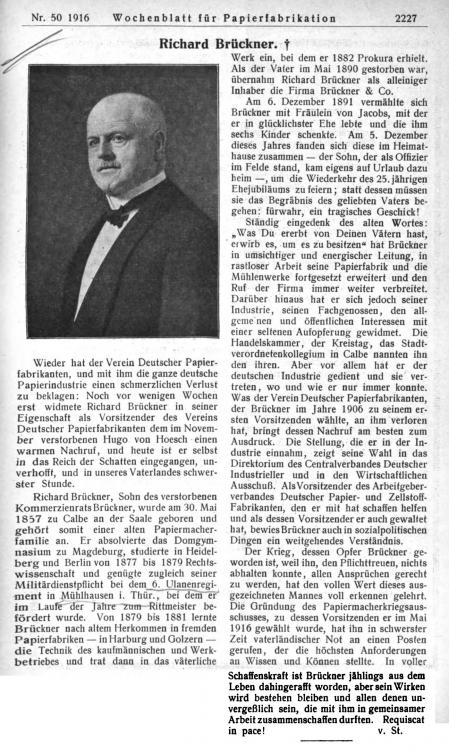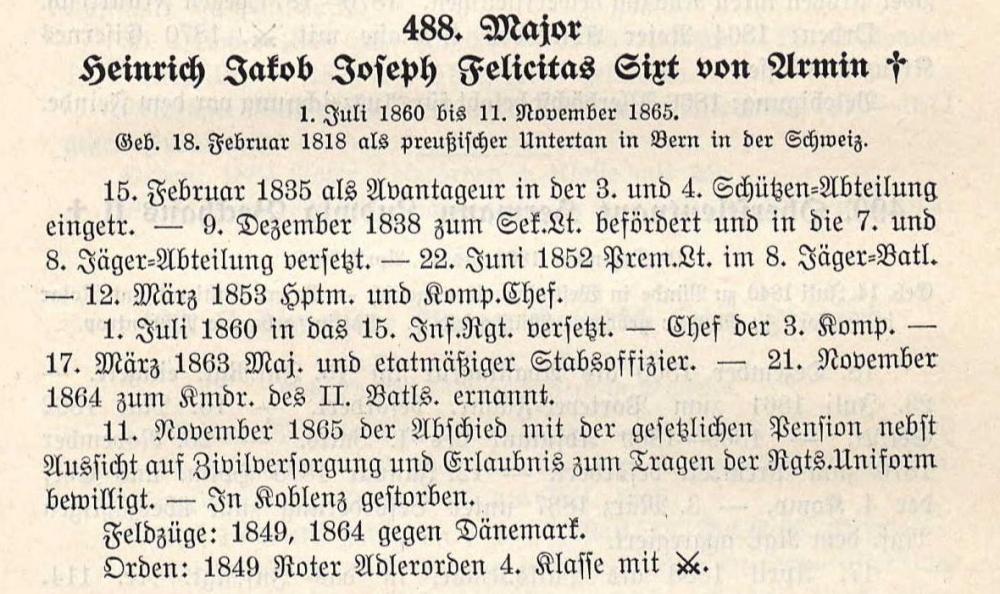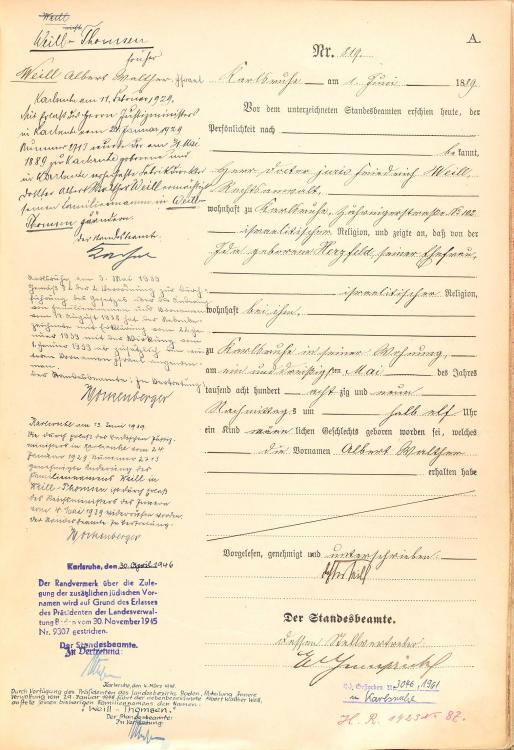-
Posts
4,908 -
Joined
-
Last visited
-
Days Won
97
Content Type
Profiles
Forums
Blogs
Gallery
Events
Store
Everything posted by Dave Danner
-
All the examples I know of were very senior government officials. For example: Theobald v. Bethmann-Hollweg, Reichskanzler Georg Graf v. Hertling, Reichskanzler Johann v. Dallwitz, Staathalter von Elsaß-Lothringen Paul v. Breitenbach, Minister der öffentlichen Arbeiten Rudolf Havenstein, Präsident des Reichsbanksdirektoriums August Lentze, Finanzminister Friedrich Wilhelm v. Loebell, Minister des Innern Siegfried Graf v. Roedern, Staatssekretär des Reichsschatzamts Clemens Frhr. v. Schorlemer-Lieser, Landwirtschaftsminister Wilhelm Solf, Staatssekretär des Reichskolonialamts Reinhold Sydow, Minister für Handel und Gewerbe
-
Looking at the image on the RIA site, I would say the missing decoration on the medal bar is the House Order of Hohenzollern, based on the ribbon and the placement of the hook. There were two Lts.d.R. Hübner with that award, but with no other known info. The Walter Hübner that Gunnar notes was wounded twice with JB 5 before going to the Fliegertruppe, according to the Kriegsrangliste-Auszug from Bavarian Armee-Flugpark 6, so the wound badge is accounted for. The roll of the Olympia-Ehrenzeichen lists "Hübner, Walter, Major, Berlin". So assuming we are talking about the same guy, probably an E-Offizier before being placed z.V.
-
Hi David, It is from the Universiry of Michigan. The Wochenblatt was digitized as part of the Hathitrust project. Fromjthe US, I can access and search it through about 1922 (later years are restricted due to copyright). From Europe, I think you are more limited since the project wanted to avoid conflicts with differing copyright laws in various other countries, although I suppose you could use a proxy. https://catalog.hathitrust.org/Record/000681213 There is also a biweekly, Der Papier-Fabrikant: https://catalog.hathitrust.org/Record/000675398
-
Maurepas stuck in my head for some reason. I thought maybe I'd been there, but I've only been in the general area. I checked some of my notes and found that a bunch of Prussian Guards officers were killed by Maurepas around that time, so not just Bavarians. For example, Lt. Hans v. Schweinichen from 1.GDR was killed there on 24 August as a Kp.Fhr. in 4.GRzF. From GGR 3, Hptm. Wilhelm v. Tippelskirch, Lts. Ernst v. Saucken, Hans-Werner Graf v. Schweinitz u. Krain Frhr. v. Kauder, and Friedrich Freiherr v. Schrötter were all killed there on 3 September. The 2.GRzF Ehrenliste shows four officers killed on 16 August, two on 18 August, 2 on 24 August and one each on 27 and 28 August by Cléry-Maurepas. Cléry-sur-Somme is about 4 kilometers south of Maurepas. There are two French military cemeteries located between the two villages. Maurepas is also a few kilometers south of Delville Wood, where the 1st South African Brigade fought in July and August and where there is a South African National Memorial.
-
Maybe someone had a three-medal bar missing those medals, and decided to fix it and sell it for some quick cash, figuring he could fix this one anytime later. There were 87 total awards of the SEK4X from Sondershausen, of which 3 were replaced with later awards of the SEK3X. Probably half can be immediately ruled out because of other awards, dying before the Third Reich so no Treuedienst possible, or too young for the Centenary. For a few recipients, the files noted that their SEM2 was returned, as was supposed to happen, but didn't always occur. Of the awards, 21 were to Feldwebelleutnants, 40 to Offizier-Stellvertreter, 12 to junior medical officials (Unterärzte and Feldhilfsärzte), and 5 to Zahlmeister. Most of the rest were to various Beamter-types.
-
Don, What is the cipher on the SEK4X? Schwarzburg-Rudolstadt had its own Dienstauszeichnung, but Schwarzburg-Sondershausen typically awarded active NCOs the silver Ehrenmedaille for 12 years' service. I think the missing one is more likely an earlier-awarded Prussian DA3 for 9 years' service or a DA1 for 15 years. An LD2 is possible, but I think he is more likely an career NCO who then took a civil service job (military service time would count toward the Treuedienst-Ehrenzeichen).
-
Erich Ernst Friedrich Steinhausen. The database of Berlin births, baptisms, etc. on Ancestry.com states that he was born on 20 July 1867 and baptised in Berlin on 16 September 1867. However, the marriage register of the Spandau garrison gives these dates as 20 March 1867 and 16 April 1867. So, someone may have confused a 20.III. with a 20.VII. and a 16.IX. with a 16.IV. I have no idea which one was correct, but my guess is the Spandau register is correct. He married Alwina Feist (*8 March 1873) on 26 September 1905.
-
Plato Boehmer served in IR 93 from 1901-11. He was in IR 21 when the war started and later went to the Fliegertruppe. Despite the IR 93 connection (he also retired with the uniform of that regiment), he did not receive the Friedrichkreuz during the war. Plato Boehmer's HOH3X was gazetted in the Militär-Wochenblatt on 12.6.1917. Ernst Böhmer's HOH3X was gazetted on 9.8.1917. The delay from award to publication in the MWB could be from a matter of weeks to 1 to 2 months.
-
The Reichswehr officer, formerly in IR 178, was Wolf Freiherr v. Biedermann, later Generalmajor in the Luftwaffe. Irminbert, known as Irmin, died in Hannover on 23.7.1954. The 1982 Gothaisches Genealogisches Handbuch des Adels lists him as an Oberstleutnant a.D., so he was apparently recalled for service in World War II. He is not in deZeng and Stankey's list of Luftwaffe officers, so he was likely a Heer officer. He also has no file in the active Heer officer files in the US National Archives, so he was probably d.R., z.V., or z.D. Kerfrid is actually Kerfried, although for some reason he was later known as Konrad (Konrad Kerfried Childebert Woldemar). He was born on 17.9.1887 (two months after Irminbert) and died in Soviet captivity in Tbilisi in 1945. Kerfried was also in SFR 108, but went to BrigEB 46 on mobilization and was severely wounded on 30.8.14. He later served in EIR 23, RJB 26, as Adj. of the Saxon Kadettenkorps and as Ord.Offz. on the staff of the 19.ED. He was an Oberst in the Heer in World War II in Wehrersatzwesen (Wehrmeldeamt Borna, Wehrbezirk Leipzig II, Wehrbezirk Döbeln). The other SFR 108 officer was Lothar, born 2.3.1898 in Leipzig. After World War I, he was promoted to Dr.jur et rer. pol. and was an Oberregierungsrat. He was a Maj.d.R. in IR 29, and was shot by the Russians in Berlin on 25.4.1945. Irminbert, Kerfried and Lothar were first cousins. Wolf was a second cousin.
-
Weill, Albert Walther, *31.5.1889 in Karlsruhe, †10.11.1961 ebenda. His name was changed to "Weill-Thomsen" on 24.1.1929. He received his Dr.jur. on 13.6.1913 from the University of Heidelberg. From 1912-29 he was a Gerichtsreferendar/Gerichtsassessor, and has a personnel file from the Baden Justizministerium in the Baden Archives. ( https://www.deutsche-digitale-bibliothek.de/item/37IKNOHECRJFFOVOMRBMYKONONGUVWQF ). Afterwards, he was a Fabrikdirektor. He was Jewish by birth, but was baptized on 27.7.1896 in Karlsruhe. On his birth certificate below, there are a number of marginal notes on the left side. First is the 1929 name change. Then there is a Nazi-era name change adding "Israel" to his given names (based on a 1938 law changing Jewish names). Then there is another Nazi-era decree reversing the "Weill-Thomsen" name change. Then, a 1946 decree reversing the Jewish name law, and a 1948 decree restoring the "Weill-Thomsen" name change. The birth certificate, and the dates of baptism and death, are from records on Ancestry.com. The date of his dissertation is from the Jahresverzeichnis der an den deutschen Universitäten und technischen Hochschulen erschienenen Schriften.
-
It was awarded with the Red Cross "without regard to rank, status or gender in recognition of sacrificial activities for the welfare of combatants and their dependents" ("ohne Unterschied des Ranges, Standes und Geschlechtes als Anerkennung einer aufopfernden Tätigkeit für das Wohl des Kämpfenden und deren Angehörigen"), according to the Landesverordnung of 25.10.1914. It was primarily awarded to civilians. In the roll, the first 12 names are "Fürstlichkeiten", mostly Schaumburg-Lippe princesses or the wives of Schaumburg-Lippe princes. At least three of these princesses were married to rulers of other states - Queen Charlotte of Württemberg, Duchess Adelheid of Sachsen-Altenburg, and Princess Bathilde of Waldeck. Serial numbers 13-44 in the roll are empty, probably to leave space for other awards to higher-ups which were never made. The rest of the roll runs from serial number 45 to 522, so 478 more awards, unless there are other gaps. I did not have time to review the entire roll, but in the Kreuz für Treue Dienste roll, there are random gaps and duplicate numbers/duplicate entries (thus the award numbers Nimmergut gives, based apparently on the last serial number in the rolls, are slightly off). Besides the roll, there are also several accompanying lists by occupation. There is a list of nurses (Verzeichnis der Vollschwestern und Hilfsschwestern) with 17 names, a list of Hausdamen with 28 names, and a list of Helferinnen with 79 names. So as Wild Card noted, there was a female version on a bow, and indeed there were quite a few awards to females. I also skimmed through the 1918 Schaumburg-Lippe court and state handbook, and there are about 40 awards shown there, mainly to court officials (male and female), government officials, doctors, teachers and pastors. There are a handful of people who have both this medal and the Kreuz für Treue Dienste am weißen Bande, since the award criteria overlap a bit. I suppose this is similar to a Prussian getting the Eiserne Kreuz am weiß-schwarzen Bande and the Verdienstkreuz für Kriegshilfe, or either of these and the Red Cross Medal.
-
Paul Skowranek received the 1902 Baden Regierungsjubiläumsmedaille as a Feldwebel in IR 142, so he can be ruled out. I can't say anything for certain about the others, although Hermann Höpfinger is a very "badisch" name. Ancestry has 31 entries for that name in the database for "Baden, Germany, Lutheran Baptisms, Marriages, and Burials". As with the Bavarian bar discussed above, however, it is possible that a native Badener might have received a Prussian long service award if he was not in a XIV.AK unit at the time of award, for example if he was in the Schutztruppe.
-
The previous owner is correct. Both Kaehne and Barchewitz had this combination. Kaehne also received the Russian Order of St. Stanislaus, but due to the war many German officers would not wear enemy awards, so that does not exclude him. Both were alive in the 1930s so they would have added the Ehrenkreuz für Frontkämpfer, and both were Forstbeamter so they may have received the Treuedienst-Ehrenzeichen. But they may have had new ribbon bars made rather than tear up the older ones. Kaehne was killed in an Allied bombing of Berlin on the night of 22./23.11.1943. Barchewitz died on 7.2.1974 in Lüneburg.
-
Indeed, Bavarians in the Navy or the Schutztruppe would receive the Prussian DA. I suppose it is possible that a Bavarian officer who returned the Bavarian Army after serving in the Schutztruppe could have both a Bavarian and a Prussian DA, or a choice of both. Do you have the seven names? I can check my Baden resources and see if any can be ruled out, for example because of the lack of a 1902 Baden Regierungsjubiläumsmedaille. Dave
-
Your best reference would be the Geschichte des Königlich preußischen Reitenden Feldjägerkorps von 1740 bis 1919, bearb. v. Otto Heym (Berlin, 1926). As Heiko noted above, the corps was not large. There were 73 Feldjäger when the war started, along with 8 Anwärter who were soon admitted to the corps. Another 43 were transferred into the corps during the war. These usually replaced those who had been transferred or commanded to regular units or were casualties. Most of those who saw action at the front served with regular units, especially Jäger batallions. 22 members of the corps were killed in World War I, but of these, only one died while in Kurierdienst (Hptm. Gustav Toepffer). 14 were killed with Jäger batallions. Two were aviators. One, Hptm. Walter v. Dreßler, was killed in the bomb attack which killed Field Marshal Hermann v. Eichhorn. Hptm. Friedrich v. Reichenau was killed in 1918 as a battalion commander in GGR 3. 47 were wounded, again mostly with regular units. Six received the House Order of Hohenzollern and 81 received the Iron Cross 1st Class. Of the 91 Feldjäger in the July 1919 rank list of the corps, 54 have Austro-Hungarian decorations, 35 have Bulgarian decorations, and 38 have Turkish decorations. They also had numerous Landesorden from the various states. Regarding transport, here is an excerpt from the history:
-
The crowns are slightly different, although you would have to look hard to tell. The dimensions and weights are slightly different as well, but again not by much. According to Nimmergut: Preußen: D1 - Kupfer vergoldet, 36,0 x 35,0 mm, 12,44 g D2 - Bronze rötlich, 30,0 mm, 14,13 g D3 - Argentan, 30,0 mm, 14,9 g Hessen: HD1 - Weißmetall vergoldet, 35,0 x 34,5 mm, 11,57 g HD2 - Bronze hell, 30,0 mm, 15,07 g HD3 - Argentan/Neusilber, 30,0 mm, 14,49 g These may be from examples which Nimmergut or others weighed and measured, so there could still be variations depending on the maker or even depending on wear. If someone did swap ribbons and medals over the last century, I doubt most anyone would have noticed.







